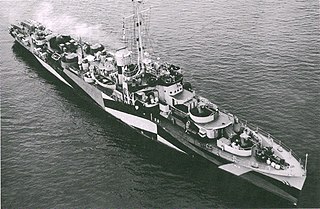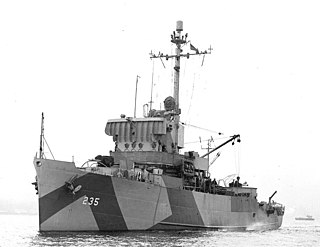
USS Crosby (DD–164) was a Wickes-class destroyer in the United States Navy during World War II, later reclassified as APD-17. She was named for Admiral Peirce Crosby.

USS Humphreys (DD-236/APD-12) was a Clemson-class destroyer in the United States Navy during World War II. She was named for Joshua Humphreys, a pioneer US shipbuilder.

USS George (DE-697) was a Buckley-class destroyer escort. She was the second ship of the United States Navy named after Seaman Second Class Eugene F. George (1925–1942), who was posthumously awarded the Navy Cross for his heroism on USS San Francisco at the Naval Battle of Guadalcanal.
The first USS Ogden (PF-39) was a Tacoma-class frigate in commission from 1943 to 1945. Originally classified as PG-137, she was the first ship of the United States Navy to be named for Ogden, Utah. She later served in the Soviet Navy as EK-10 and in the Japan Maritime Self-Defense Force as Kusu (PF-1), Kusu (PF-281), YAS-50 and YAC-22.

The second USS Gallup (PF-47), a Tacoma-class frigate in commission from 1944 to 1945 and from 1950 to 1951, was the first ship of the United States Navy to be named for Gallup, New Mexico. She also served in the Soviet Navy as EK-22 and in the Royal Thai Navy as HTMS Prasae.

USS Gantner (DE-60/APD-42), a Buckley-class destroyer escort of the United States Navy, was named in honor of Boatswain's Mate Samuel Merritt Gantner (1919-1941), who was killed in action during the Japanese attack on the Hawaiian Islands.

USS Surfbird (AM-383) was an Auk-class minesweeper built during World War II for the United States Navy. She was the only U.S. Navy ship named for the surfbird.
USS Execute (AM-232) was an Admirable-class minesweeper built for the United States Navy during World War II. She was originally ordered and laid down as USS PCE-905, the lead ship of the PCE-905 class of patrol craft. She was reclassified as an Admirable-class minesweeper by the time of her June 1944 launch, and named Execute by the time of her November 1944 commissioning. After service in the Pacific during World War II, she was decommissioned in August 1946 and placed in reserve. While she remained in reserve, Execute was reclassified as MSF-232 in February 1955 but never reactivated. In 1962, she was sold to the Mexican Navy and renamed ARM DM-03. In 1994, she was renamed ARM General Juan N. Méndez (C51). She was stricken in July 2001, but her ultimate fate is not reported in secondary sources.

USS Ampere (PCE-919/AM-359/YDG-11/ADG-11) was originally planned as a PCE-905-class patrol craft for the United States Navy, PCE-919, and laid down as an Admirable-class minesweeper, named Drake, for the male duck. Before she was commissioned, her name was cancelled and she was reclassified as a District Degaussing Vessel. She was later renamed Ampere, after the ampere, a unit of electric current, which takes its name from the French physicist André-Marie Ampère.
USS Deperm (ADG-10) was a degaussing vessel of the United States Navy, named after the term deperm, a procedure for erasing the permanent magnetism from ships and submarines to camouflage them against magnetic detection vessels and enemy marine mines. Originally planned as a patrol craft escort (PCE-883), she was laid down in 1943, launched in 1944, and commissioned in 1945. She was subsequently redesignated a degaussing vessel, YDG-10, and named Deperm.
The third USS Magnet (ADG-9) was a degaussing vessel of the United States Navy, named after the magnet. Originally planned as a patrol craft escort (PCE-879), she was laid down on 27 May 1943 by the Albina Engine & Machine Works of Portland, Oregon; launched 30 September 1943; reclassified YDG-9 on 23 December 1943; and commissioned 10 July 1944.

USS Parris Island (AG-72) was a patrol craft escort named for Parris Island, South Carolina.
USS Dextrous (AM-341) was an Auk-class minesweeper built for the United States Navy which served in World War II, the Korean War, and beyond. She was later transferred to the Republic of Korea Navy where she served as ROKS Koje (PCE-1003).
USS Facility (AM-233) was an Admirable-class minesweeper built for the United States Navy during World War II. The ship was ordered and laid down as PCE-905-class patrol craft USS PCE-906 but was renamed and reclassified before her June 1944 launch as Facility (AM-233). After earning three battle stars for service in the Pacific during World War II, she was decommissioned in September 1946 and placed in reserve. While in reserve, Facility was reclassified as MSF-233 in February 1955 but never reactivated. In October 1962, she was sold to the Mexican Navy and renamed ARM DM-04. Her ultimate fate is not reported in secondary sources; she may have been out of service by April 1973 when another member of the Admirable class was acquired by the Mexican Navy and given the name DM-04.
The second USS Dempsey (DE-26) was an Evarts-class destroyer escort constructed for the United States Navy during World War II. She was promptly sent off into the Pacific Ocean to protect convoys and other ships from Japanese submarines and fighter aircraft. By the end of the ship's World War II service career, when she returned to the United States, she had accumulated three battle stars.
USS Compel (AM-162) was an Admirable-class minesweeper built for the U.S. Navy during World War II. She was built to clear minefields in offshore waters, and served the Navy in the Pacific Ocean. Compel was awarded one battle star for World War II service.

USS Fixity (AM-235) was an Admirable-class minesweeper built for the United States Navy during World War II. The ship was ordered and laid down as PCE-905-class patrol craft USS PCE-908 but was renamed and reclassified before her December 1944 commissioning as Fixity (AM-235). She earned two battle stars in service in the Pacific during the war. She was decommissioned in November 1946 and placed in reserve. In January 1948, she was transferred to the United States Maritime Commission which sold her into merchant service in 1949. Operating as the Commercial Dixie, she sank in the Ohio River in the late 1990s.
USS Gavia (AM-363) was an Admirable-class minesweeper built for the United States Navy during World War II. The ship was ordered and laid down as PCE-905-class patrol craft USS PCE-907 but was renamed and reclassified before her September 1943 launch as Gavia (AM-363). She earned two battle stars in service in the Pacific during World War II. In May 1946, she was turned over to the Republic of China for service with the Chinese Maritime Customs Service as Yung Chun. She was removed from service in June 1962.

USS Lamar (PCE-899)/USCGC Lamar (WTR-899) was a PCE-842-class patrol craft acquired by the U.S. Navy during World War II for the task of patrolling assigned ocean areas or protecting larger ships in convoy.
ROKS Dangpo was a patrol craft of the Republic of Korea Navy (ROKN). Originally built as USS PCE-842, a PCE-842-class patrol craft for the United States Navy during World War II. Dangpo was acquired by South Korea on 13 December 1961 and sunk by North Korean coastal artillery fire on 19 January 1967.










